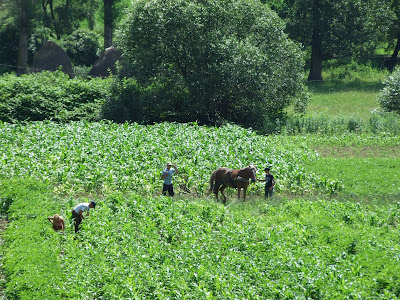Tibor Hartel
Rural landscapes were shaped by human activity, which sometimes can be tracked back to centuries. These landscapes represent a fascinating subject for applied conservation and research. I consider as “conservationist” every academic person who is actively involved in the conservation of cultural values of these societies. This can be an architect or anthropologist or ecologist. Preferably all together in a mixed team. In this note I highlight some aspects related to traditional and new values, changes in these values (which we, as conservationists of Eastern Europe
When is a rural community (with its “extended phenotypes” such are the cultural products) traditional? Difficult question, especially because of the many uncertainties around the word “traditional”. From an Eastern European and Romanian context it seems that the “cultural heritage” of the traditional rural communities can be tracked back for centuries. The traditional costumes, traditional songs and dances, poems, or architectural products (houses, churches etc.) and nevertheless landscapes are just a few of the many cultural values produced and maintained by rural societies. Although these may change during time (since societies are not isolated entities, infiltration occur from other cultures as well – see for example the Saxon-Hungarian-Romanian interface in the Southern part of
Picture 2. The new Sighisoara. The arrow show an unfinished huge building which (i) occupies a lot of space and (ii) is “architecturally mutilating” the town. Source: internet
Picture 3. If the visitor come into Sighisoara (a town built and shaped by Saxons along the centuries) from
Picture 4. I experienced a “remarkable constancy” in the architecture of Finnish (and also Swedish) buildings across that huge country. They were beautifully diverse but at the same time so clearly representative.
Societies are changing, and most likely nothing can be done to stop this process. What need to be done is to help societies adapt (their institutions) to change.
I don’t know how much from the old values will be kept in the newly formed society after and during the institutional change. Conservationists are fighting to keep as much as possible - and I dont know how 'fair' is this or not. If one can manage to “plant” these values in the “core” of the (new) institution (or, why not, to build one around these values) then we may be optimistic. But this is hard to do, and it seems that most of conservationists from
To be efficient in our conservation attempts in a changing world, we need to know what the major driver (or what kinds of drivers operate - since likely there is more than one) of change is. If we understand this, we can assess better our aims, limits and possibilities and also we could allocate resources more efficiently.
If I would try a quick attempt to identify drivers of (institutional) change this would be not hard at all. From individual perspective some short bits could be: The wish to work less and gather more (and more). To feel safe. To feel good. To be healthy. To be sexually attractive. To have money, power (as much as possible). To be independent. (or: to be in a level of social hierarchy which assure more and more independence) To travel around the world. To know more, think more. To have fun. (these are what I generally see around, and I am sorry if the reader lack any or all of them)
If the existing cultural products and heritage allow at least the illusion of having some of the above mentioned things, then it is likely that people will keep them. Otherwise, likely they will dissapear or be markedly changed.
Now, how many milliseconds should be spent to realize how much of these may have a family which is doing something like that presented in Picture 5 especially when they are young and know that in their surroundings there is a life which is presented in Picture 6?
Picture 5. Upper picture: young people making traditional farming in a Saxon village. Picture below: a short brake during agricultural work with my grandmother, mother and a villager who come to help.
Picture 6. Youth in a party in
There are, of course, a number of global-institutional drivers acting more or less independently from the above mentioned ones.
To come back to our problem: how to conserve values when the societies and value systems are rapidly changing? First, I really think that conservation work needs to be done. Other way, we loose all the important reference points. But what and how and how much? As a conservation biologist I would say: life, before all! I would invest a lot of energy and resource to understand the 'behaviour' of a social and ecological system under various circumstances: how adaptive and resilient that system is. Which are the key features of that given system which assures resilience and adaptability. Building or forming, (new) institutions and value systems - dont forget: we live in sharply changing times - would be of critical importance to achieve this goal even if this would mean the “broke” with many traditional values (traditional “cultural packages” should be “filtered”).






